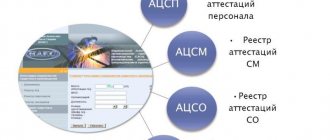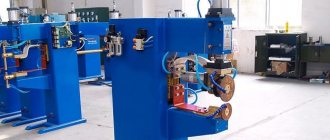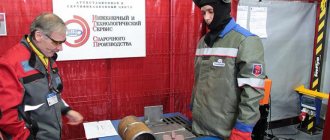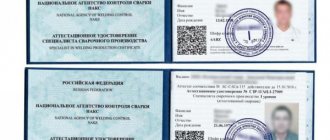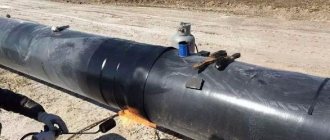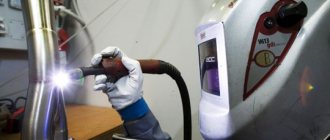Certification of welding technology is the process of verifying the organization’s compliance with the requirements of NAKS (National Welding Control Agency), namely the availability of technological capabilities, certified personnel and developed documentation. Makes it possible to carry out welding work at hazardous production facilities.
For any company carrying out reconstruction, installation or production using welding at hazardous facilities, it is mandatory to have a certificate of certification of welding (surfacing) technology. This procedure is regulated by document RD 03 615 03. In this article we will talk about the main points that you will encounter when receiving this document
Who is checking and what is being checked?
Certification is carried out by certification centers for certification of welding technologies (ACST). They are in every region; you can find them on the official website of the National Welding Control Agency in this section.
Directly during the certification process, the certification center commission checks the following:
- Availability and compliance with the requirements of production and technical documentation (PDD). These are technological instructions and technological maps
- Availability of certified personnel. 1 level 3 specialist (technologist) and at least two welders. Naturally, the ID must be valid
- Certified equipment and welding materials (Equipment and materials, as a rule, are purchased already certified
- Certificates for the metal or other material used (for example, plastic, if we are talking about ZN or NI welding)
- Test welded connections. During testing, welders weld samples (SSC), which are then tested in a non-destructive and destructive testing laboratory.
- Availability of an agreement with the laboratory that will test the CSS
NAKS - what is it?
The National Welding Control Agency is a self-regulatory organization specializing in certification of welding production, technological methods, and equipment for performing these works. If the plant assessment is successful, information about it is entered into a register accessible to everyone. Any potential client of a company can view information from this register to ensure that its activities comply with legal requirements. NAKS also issues a certificate of certified welding technology.
The key purpose of issuing such a document is to ensure reliability, safety and quality, and to protect clients from unscrupulous service providers.
Obtaining it is important primarily for the company itself. This gives it the opportunity to operate in the Russian and European markets. Application for certification of welding technology
Procedure for certification of welding technology
The organization submits a package of documents to the certification center, which checks the application, PDD, technological maps, documents for people and equipment. AC NAKS issues a contract and an invoice for payment, then a welding technology certification program is drawn up for this enterprise. After this, a commission visit is organized to the site or production base of the company, where welders weld samples of the welded joints and the commission takes photographs. Next, the welded samples are transferred to the laboratory, where tests are carried out (mechanical and non-destructive). After which NAKS gives a conclusion on the readiness of the applicant organization to use certified welding technology.
This is what the certificate looks like And this is what the application looks like (also known as the distribution area)
Certification of welding and surfacing technologies (hereinafter referred to as welding) is carried out in accordance with the requirements of RD 03-615-03.
Welding technologies used in the manufacture, installation, repair and reconstruction of technical devices, equipment and structures of hazardous production facilities (hereinafter referred to as HPF) are subject to certification.
In accordance with the requirements of RD 03-615-03, the use of uncertified technologies in the manufacture, installation, repair and reconstruction of technical devices, equipment and structures of hazardous production facilities is not allowed.
Production certification of welding technology is carried out in order to confirm that the organization engaged in the manufacture, installation, repair or reconstruction of technical devices, equipment and structures used at hazardous production facilities has the technical, organizational capabilities and qualified personnel to perform welding (surfacing) using certified technologies, as well as checking that welded joints (surfacing) made in the conditions of a specific production using the certified technology ensure compliance with the requirements for hazardous production facilities of general and special technical regulations, and before they enter into force - regulatory documents approved or agreed upon by the Gosgortekhnadzor of Russia, design (in terms of requirements for welding and quality control) and technological documentation. Technical as the presence of certified welding equipment, the availability of tools, devices, equipment that ensures the performance of high-quality welded joints. Organizational as the presence within the organization (or hired under a contract) of units that provide:
- development and updating of production and technological documentation;
- maintenance and repair of equipment, tools, devices;
- Carrying out incoming inspection and preparing materials;
- high-quality preparation, assembly, welding, heat treatment of parts;
- operational control;
- acceptance control of welded joints;
- and other measures to ensure the quality of welded joints.
To carry out industrial certification of welding technology, the applicant organization must submit appropriate documentation containing instructions on the welding and auxiliary equipment used, welding (surfacing) methods, basic and welding materials used, design and dimensions of welded parts and welds, modes and technological methods for performing welding works, requirements for assessing the quality of welded joints.
Before certification, the applicant organization must have duly approved technical documentation for the technology for performing welded joints (surfacing), certified welding equipment, as well as welding production personnel certified in accordance with PB 03-273-99 RD 03-495-02, ensuring compliance requirements.
To ensure certification, the management of the applicant organization by order appoints a representative responsible for the provision of materials, preparation of control welded joints, implementation of incoming inspection of materials, preparation of materials, assembly and welding of joints, operational and acceptance control of welded joints, as well as provision of other activities necessary for conducting the certification process.
Based on the application and production and technological documentation of the applicant organization, the certification center draws up a production certification program and coordinates it with the applicant.
The program specifies:
- name and scope of application of the certified technology;
- main technological characteristics of welded joints performed during certification tests;
- methods of non-destructive testing of welded joints (surfacing);
- types and volumes of certification tests of welded joints and weld metal (welded metal) by destructive testing methods;
- control and testing methods;
- requirements for quantitative characteristics of quality indicators of welded joints;
- other data specific to the technology being certified;
- requirements for the results of non-destructive and destructive tests.
Production certification is carried out by the certification center together with the applicant organization by performing in the production conditions of the applicant organization and subsequent monitoring of them using non-destructive and destructive methods by the laboratory of the applicant organization (or hired under a contract).
Welding of control welded joints must be performed by welders of the applicant organization, certified in accordance with PB 03-273-99 and RD 03-495-02 using certified welding equipment.
Welding of control welded joints is carried out in the presence of a member of the AC certification commission and a representative of the applicant organization, who monitor the execution of operations for preparation, assembly, heating, welding and heat treatment, as well as the preparation of welded joints for subsequent control.
Based on the results of production certification, the certification center draws up a Conclusion on the readiness of the applicant’s organization to use this technology.
The Conclusion states that, based on the positive results of control and testing, the certified technology can be approved for performing welded joints (surfacing) at the relevant hazardous production facilities, and provides the basic data and requirements characterizing the specified technology, including:
- name and scope of application of the certified technology;
- brand(s) of materials of welded (surfaced) parts (indicating standards or technical conditions);
- welding method (surfacing);
- permissible range of thicknesses and diameters of welded parts;
- brand (combination of brands) of welding materials indicating standards or technical conditions;
- permissible welding (surfacing) positions;
- the need and modes of preliminary and auxiliary heating;
- recommended welding (surfacing) modes;
- the need, type and modes of heat treatment of welded joints and surfacing;
- indicators and quantitative characteristics of welded joints, weld metal and deposited metal made using the certified technology (from those provided for in the test program).
The certification center transfers the results of production certification to NAKS for examination and registration of a Certificate of readiness of the applicant organization to use the certified welding (surfacing) technology.
Welding technology certification register
Data on the certification of the enterprise are entered into the public register on the NAKS website, which guarantees its authenticity. It is available at this link. It is better to check using the certificate number and the registration number of the certification center, since a search by the name of the organization does not always work correctly.
Why and who needs this?
Note! The activities of the commission are regulated by special regulatory documentation. All requirements that the commission imposes on the applicant organization are regulated by the designated documents.
In addition, the certificate of certification of welding technology will have to be re-obtained by those organizations that make changes to previously certified technologies that were not provided for in the previously obtained certificate.
Extraordinary certification is carried out at the request of regulatory authorities or technical control services on the part of the customer.
Production certification of welding technology under the supervision of NAKS is carried out in stages. The procedure is complex and capacious, each stage is characterized by certain features and subtleties. Knowing these nuances will help the organization avoid troubles in the future.
Main types of research conducted by NAKS:
- research testing is carried out within the framework of current legislation and is aimed at confirming compliance or identifying non-compliance with the characteristics of welds made from both plastic and metal materials;
- production inspection is necessary to monitor organizations and enterprises carrying out welding work at high-risk facilities. Production inspection under the control of NAKS can be primary, secondary or extraordinary.
How to get a certificate
Any specialist who has the appropriate education, qualifications and the necessary professional training can undergo certification.
- The candidate submits an application, documents on education and qualifications, and a certificate of employment to the certification center.
- Within 3 days, makes a decision on approval of the application. If the application is rejected, the certification center will notify you in writing of the reason for rejecting the application.
- Certification of welders consists of testing knowledge of welding theory and practical skills of a specialist. For level 1 certification, the test includes at least 15 theoretical questions; for welders of levels 2, 3 and 4 – at least 20 questions. Theoretical knowledge is tested using a computer or in writing using teaching materials developed by the certification body. An additional interview may also be conducted. The theoretical part is considered passed if the candidate answers 80% of the questions correctly.
- When testing practical skills, they are guided by NAKS and GOST documents, which regulate the conduct of practical tests. The test is passed if the specialist has completed a practical task in accordance with the declared area of certification. A candidate who successfully passes the test is issued a certificate.
- If a candidate fails the theory or practical skills test, he has the right to retake this part within 3 months at the same certification center. A candidate who does not pass the re-test is considered to have failed the certification and receives a written refusal of certification.
- The certificate number of a certified specialist is entered into the NAKS register. Using the registry, you can find out when the certification was carried out, the scope of certification, and the validity period of the document.
For welders the certificate is valid for 2 years, for welding production employees of levels 2 and 3 it is valid for 3 years, for level 4 – 5 years.
Various levels of NAKS certification
Having a NAKS certificate today is becoming an important condition for a welding specialist to be able to do his job. The national agency has developed a procedure and the necessary rules that a specialist must comply with. Certification is carried out by regional representative offices of the agency, after the conclusion of the certification commission. This is an authorized body, which includes qualified experts from NAKS, as well as specialists from Rostechnadzor.
NAKS experts have special certification; they are included in the agency’s own register. The NAKS certificate of a welder is intended to confirm his sufficient professional level and his suitability for performing certain work.
There are 4 levels of certification that a specialist can now undergo at NAKS;
- Certified welder;
- Certified master welder;
- Certified welding technologist;
- Welding engineer.
Mandatory certification will be required for specialists who want to acquire permits for particularly critical work performed in hazardous and difficult conditions. In addition, specialists of level above 1, who are managers of an enterprise or its division, must also undergo mandatory certification.
NAKS certification: welder levels
Determination of qualification level is carried out according to four levels:
- the first is a NAKS welder . The organization of independent experts gives the specialist the go-ahead to weld critical structures;
- the second is a master welder . Higher level specialist. He can not only perform, but also control the welding process, as well as give instructions on the correct execution of specific technological operations. Recommendations can be made either orally or in writing;
- the third is a technologist . In charge of monitoring all welding processes at the enterprise;
- the fourth is an engineer . Heads of services who are involved in monitoring welding processes of any level of complexity and are the heads of the relevant services.
It is important to emphasize that NAKS certifies not only specialists, but also equipment that is used to perform technological operations. In other words, the agency is called upon to control personnel, process and equipment.
Welders undergo three stages of testing: primary, repeated and extraordinary. The purpose of the events is two important points:
- the company’s readiness to perform a certain type of work on joining metals;
- confirmation of the level of training of specialists who are allowed to carry out responsible welding operations.
Welding operator card
After completing training and testing as part of additional professional education under advanced training programs, a welder can be enrolled in the register of ASPM (Association of Welders of Polymer Materials) and receive a welder-operator card confirming his qualifications.
In all cases, personnel performing installation and welding of pipelines must undergo appropriate specialized training and confirm their qualifications based on the results of a practical exam. And, personnel working with polymer pipelines can present an operator identification card suitable for working with electronic documents.
More information about the ASPM welder card
Without being included in the register, the certificate of a welder or welding specialist (NAKS certificate) is considered invalid.
Why is this so important
Production certification of welding technology is of great importance for those manufacturers who provide relevant services. The competence of NAKS directly includes making a decision on the possibility of using certain technological methods in a particular production, which is made based on the results of the assessment. For this reason, it should be treated extremely responsibly.
The inspection is initiated by the enterprise itself. It submits an application, prepares for the arrival of the commission, demonstrates to it the availability of modern equipment and qualified personnel capable of performing high-quality welding work. In addition, it is important that the company strictly observes all fire safety and labor laws. Certification of NAKS technology is considered mandatory for any hazardous production.
During a factory visit, inspectors conduct an assessment to determine whether the work process is safe and whether the resulting product will be of sufficient quality. No less importance is given to the study of materials used by welders.
REGULATIONS
RD 03-614-03 “Procedure for the use of welding equipment in the manufacture, installation, repair and reconstruction of technical devices for hazardous production facilities” Open
Order of the Gosgortekhnadzor of Russia No. 14 dated January 28, 2004. “On the introduction into force of the Procedure for the use of welding equipment in the manufacture, installation and reconstruction of technical devices for hazardous production facilities” Open
Resolution of the Gosgortekhnadzor of Russia No. 102 dated June 19, 2003. “On approval of the Procedure for the use of welding equipment in the manufacture, installation, repair and reconstruction of technical devices for hazardous production facilities” Open
The procedure for certification and its cost
NAKS certification (except for cases of assignment of the fourth level) is carried out in the following stages:
- sending the application and package of documents to a certified certification center . You can send documents on a territorial basis or by making a choice in accordance with concluded agreements on a price basis. In addition, when sending documents, the timing of events and issuance of documents should also be taken into account;
- coordination of the timing of certification and its location (on the basis of a certification center or point or with representatives of the center visiting the workplaces of the groups being certified);
- the arrival of an employee of the certification center at the site or the persons being certified at the location of the center or point;
- completing training in accordance with the program for a specific form of admission;
- passing practical, theoretical and special exams (the latter is taken if necessary);
- obtaining a NAKS certificate in case of successful passing of all necessary exams.
Certification for the fourth level takes place exclusively on the basis of certification centers due to the need for the presence at all examination events of at least three teachers who also have a fourth level in the NAKS system.
The cost of certification varies depending on the certification center or point, level, group of materials, its frequency or primacy, as well as the number of groups undergoing training simultaneously with certification. The range per person, depending on all the listed parameters, varies from five to one hundred thousand rubles per person, however, the specific amount should be found out in each case separately.
Welder's certificate
All certification activities are completed by receiving a certificate created according to the NAKS qualification requirements system. This document, which gives the right to perform certain types of work, contains the following information:
- information about the person to whom the certificate was issued (with his photograph);
- information about the certified certification center or point where the certification took place;
- date of issue of the document and its validity period;
- groups of equipment and materials covered by this document.
If you lose it, you will have to undergo certification again with a change in its validity period.
Validity
Depending on the assigned qualification level, the validity period of the issued certificate varies:
- For welders and welding production specialists assigned the first and second levels, the validity period of the certificate cannot exceed two years . Extension of such a certificate is possible for no more than one year; in some cases, for specialists with the second level, extension is permissible for one and a half years twice. The number of such extensions cannot exceed two;
- A welding specialist assigned the third level can use his certificate for three years . Extension is possible twice for up to two years;
- If a welding specialist is assigned the fourth level, then the validity of the certificate cannot exceed five years . An extension is permissible for a period of three to five years, depending on the specialist’s field of work; the number of such extensions cannot be more than two.
Sample NAKS welder certificate
If the certificate has expired and renewal options have been exhausted, a new certification is carried out and a new certificate is issued.
